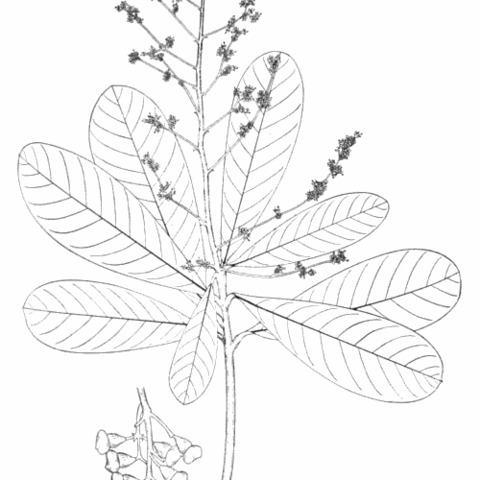Tree up to 20 m high and 50 cm Ø, rarely treelet 4 m high and 10 cm Ø. Leaves spaced, spiral, subcoriaceous or coriaceous, obovate-oblong or oblanceolate, elliptic or elliptic-lanceolate, rarely narrow-elliptic, 8-35 by 2-9 cm (up to 43 by 16 cm on vegetative twigs); upper surface glabrous, rarely sparsely puberulous, lower surface densely sometimes sparsely tomentose, pubescent or puberulous, glabrescent, rarely glabrous; papillae distinct, covering the lower surface except the midrib, nerves, and thicker veins; base cuneate, or obtuse; apex variable, acute, shortly and abruptly acuminate, obtuse, rounded, rarely retuse; nerves 11-25 pairs, prominent beneath, flat above; veins reticulate, some cross-bar-like, slightly elevated beneath, distinct or faint above; petiole ½-3l/2(-5) cm. Panicles terminal, sometimes also axillary, up to 40 cm long, tomentose or pubescent; lateral branches obliquely ascending, up to 20 cm long; bracts ovate to linear, ⅓-3 mm; pedicels 0 or very short. Flower-buds subglobose. Flowers greenish white. Calyx lobes triangular, ½-1 mm long. Petals imbricate, ovate-oblong, or elliptic, 1½-3 by ⅔-1½ mm, puberulous outside, sometimes glabrescent, with several longitudinal veins. Stamens 2½-3 mm; anthers broad-ovoid, c. ⅔ mm long. Imperfect or sterile stamens in ♀ c. 1 mm. Disk round, flat sometimes slightly convex above, 1-2 mm Ø, pilose above. Ovary dome-shaped, c. 2 mm Ø, densely pubescent; styles c. 1 mm. Drupe ovoid or broad-ellipsoid, 1-1¼ by ¾-1 cm, sparsely hairy, glabrescent; apex obtuse; hypocarp obconical, ½-⅔ by ½ cm.
More
Trees, 4-20 m tall; branchlets brownish. Petiole 1-3 cm, sparsely pubescent; leaf blade obovate-oblong to narrowly elliptic, 8-35 × 2-9 cm, leathery, adaxially glabrous to minutely pubescent, abaxially variable in hairiness from densely tomentose or pubescent to rarely glabrous, with distinct papillae except on midrib and major veins, base cuneate to obtuse, margin entire, apex variable from acute to rounded, lateral veins 11-25 pairs, prominent abaxially, reticulate venation prominent abaxially, distinct to indistinct adaxially. Inflorescence paniculate, 15-30 cm, tomentose or pubescent; floral subtending bracts 0.5-3 mm. Pedicel missing or very short; flowers greenish white. Calyx lobes broadly ovate, 0.5-1 mm, obtuse apically. Petals ovate-oblong to elliptic, 1.5-3 mm, minutely pubescent to glabrous, longitudinally veined. Stamens 2.5-3 mm; anthers ca. 0.7 mm; staminodes in female flowers ca. 1 mm. Disk round, flat, 1-2 mm across, pilose. Ovary ca. 2 mm across, densely pubescent. Drupe ovoid to broadly ellipsoid, 1-2 × 0.7-1.5 cm, apex obtuse, lower part covered by hypocarp.
A large tree. It grows 4-20 m tall. The leaves are crowded at the ends of the branches. The leaves are rounded or somewhat pointed at the tip and pointed at the base. The flowers are white and carried in compound flower clusters that are longer than the leaves. The fruit are like cashew but smaller. The fruit has a stone and is carried on a purple stalk.
In dry thickets, primary and secondary forest in lowland areas, sometimes ascending to elevations of 600-700 metres, and very occasionally to about 1,200 metres.
More
In dry thickets, primary and secondary forest in the lowland, sometimes up to 600-700 m, occasionally up to c. 1200 m. Fl. fr. Jan.-Dec.
A tropical plant. They are common in dry areas and secondary forest from Luzon in the Philippines. They are not recorded from Mindanao.

